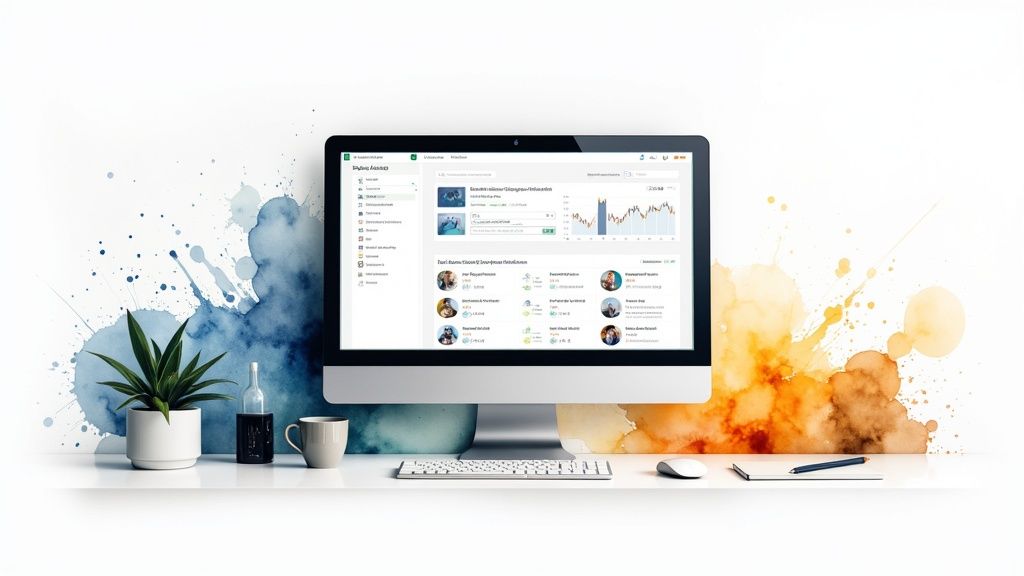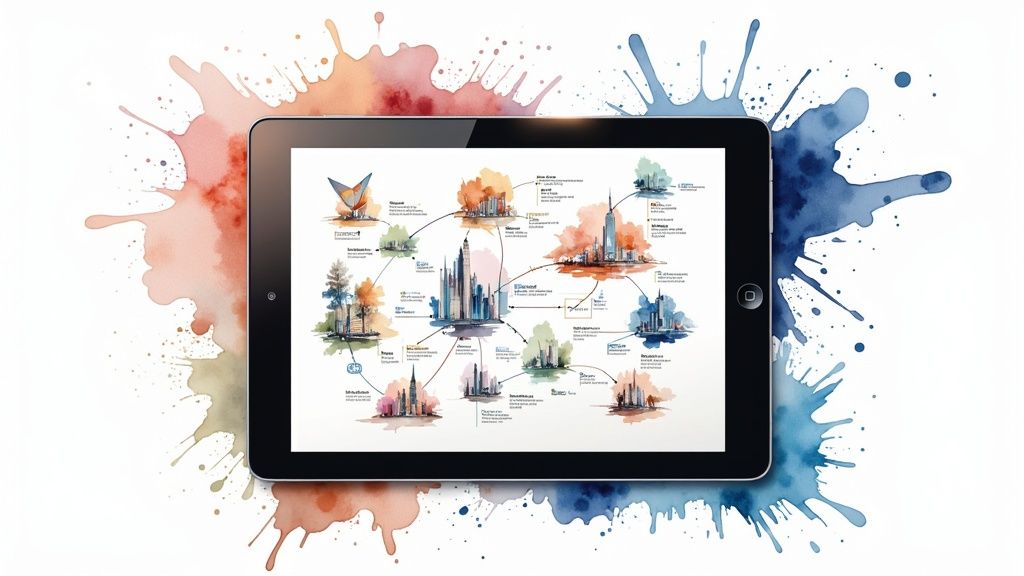Understanding Modern Digital Asset Management Solutions

Managing an expanding collection of digital files - from images and videos to documents and presentations - has become essential for businesses. The right system makes a huge difference in keeping brand materials consistent, making workflows smooth, and hitting business targets. That's where digital asset management (DAM) systems shine, offering much more than just file storage.
Think about a marketing team searching for their company's latest logo for an upcoming campaign. Without a DAM system, they might waste hours digging through folders, emails and drives. But with DAM, they can find exactly what they need in seconds - the right version, ready to use.
How DAM Solutions Solve Key Business Challenges
Modern DAM systems tackle several critical business needs:
- Version Control: Track file versions so everyone uses the latest approved assets
- Brand Consistency: Keep brand materials unified by giving teams access to approved files
- Team Collaboration: Share and work on files smoothly, both inside and outside the company
- Faster Workflows: Speed up content creation and distribution with automation
This means less time hunting for files and more time for important work. Teams can launch campaigns faster when they can quickly find and share what they need. The DAM market reflects this value - it's worth $4.7 billion in 2023 and expected to reach $20.3 billion in coming years, growing at 17.7% annually. This growth comes from businesses seeing real returns on their DAM investments. Learn more about market growth. Related reading: How to master quality content.
The Evolution of DAM: Beyond Basic Storage
Early DAM systems focused mainly on storing and finding files. Today's solutions add powerful features like AI-powered tagging, automatic metadata generation, and smart search to help users quickly locate assets in large content libraries.
Many DAM platforms now connect smoothly with other marketing tools like content management systems (CMS) and marketing automation software. This creates a connected system where content flows easily between tools, helping teams work more productively. As content needs grow, DAM systems will keep playing a bigger role in helping businesses work efficiently and grow.
Essential Features That Drive Business Value
Your digital assets need more than just a storage system - they need a powerful management solution that helps your team work smarter. Let's explore the key features that make digital asset management (DAM) truly worthwhile for businesses.
Search and Metadata: The Foundation of Findability
Finding the right file quickly comes down to great search capabilities. Modern DAM solutions use metadata - descriptive information about each asset - to deliver precise search results. Like detailed labels, metadata captures everything from basic file info to usage rights and people featured. This means your team can search with remarkable specificity, like "high-res coffee cup photos from 2023 approved for web use." No more endless scrolling through folders.
AI-Powered Tagging: Automation for Efficiency
Adding metadata tags manually takes significant time. That's where AI tagging comes in. These smart systems automatically analyze assets and apply relevant tags, saving countless hours of manual work. The AI can identify objects, people, and even emotional tones in images and videos, making assets much easier to find later.
Automated Workflows: Streamlining Content Operations
Modern DAM platforms include automated workflows that handle routine tasks automatically. For example, when someone uploads a new product image, the system can notify the marketing team for approval, create versions in different sizes, and distribute them to the right channels - all without manual steps. This automation reduces errors while ensuring brand consistency.
Integrations: Connecting Your Digital Ecosystem
A good DAM solution works smoothly with your other essential tools. By connecting with your content management system, marketing platforms, and creative software, assets can flow easily between teams and applications. This means everyone has access to the latest approved files, no matter which tools they use. Learn more about Aeon's powerful features.
Access Control and Permissions: Protecting Your Valuable Assets
Strong security measures protect your digital assets through access control and permissions. Administrators can set specific rules about who can view, download, edit and share different types of content. This granular control ensures sensitive materials stay protected while teams still get access to what they need. Different permission levels help maintain brand standards and protect intellectual property.
Mastering DAM Implementation Success

Getting a Digital Asset Management (DAM) system up and running takes more than just picking software. You need clear goals, engaged teams, and smart planning to make it work. Here's how to set your DAM project up for success.
Securing Stakeholder Buy-In
Start by showing each team how DAM solves their specific problems. For marketing, highlight faster content delivery. For creative teams, emphasize easier file sharing. For IT, focus on reduced storage costs. When people see direct benefits, they're more likely to embrace the new system.
Designing Effective Workflows
Map out exactly how your teams will use the DAM system day-to-day. Look for tasks that can be automated, like adding tags to files or managing versions. Think through how the DAM will fit with tools your teams already use. Good planning here prevents headaches later.
Ensuring Widespread Adoption
The best DAM system won't help if nobody uses it. Create a mix of training options - hands-on sessions for those who learn by doing, written guides for reference, and quick video tutorials for visual learners. Share success stories from early adopters to build momentum.
Avoiding Common Pitfalls
Watch out for two big issues: poor metadata and weak change management. Without good metadata (descriptions, tags, categories), finding files becomes frustrating. And if you don't help teams adjust to the new system through clear communication and support, adoption will suffer.
Tracking Progress and Measuring Success
Set clear goals for your DAM system tied to business results. Track metrics that matter, like time saved finding files, percentage of brand-approved assets used, and reduction in duplicate content. Regular check-ins on these numbers help prove the system's value and spot areas for improvement.
Maximizing Return on Your DAM Investment

Understanding the return on investment (ROI) from your digital asset management system helps prove its worth beyond just numbers. A thorough ROI analysis shows how DAM improves both daily operations and your company's results.
Measuring the Direct Cost Savings of DAM
The clearest benefit of DAM comes from direct cost savings in several key areas:
- Time Saved Searching: Count how many hours staff spend hunting for files. When a designer saves an hour per day finding assets, those hours add up to major savings over months and years.
- Less Duplicate Work: Many teams recreate files because they can't find originals. DAM stops this waste, especially important for companies managing thousands of assets.
- Better Asset Reuse: DAM makes it simple to reuse existing content across channels, reducing the need to create everything from scratch. One asset serves multiple purposes.
Identifying the Indirect Benefits
Beyond pure cost savings, DAM delivers other valuable advantages:
- Consistent Branding: A central hub for approved materials keeps brand identity uniform everywhere. This builds stronger customer recognition and trust.
- Speed to Market: Quick access to assets helps teams launch campaigns and products faster. Getting to market ahead of competitors provides a real edge.
- Team Collaboration: DAM improves how internal teams and external partners work together, leading to better results.
Building a Business Case for Continued DAM Investment
To ensure ongoing DAM funding, you need clear proof of its value through:
- Key Metrics: Track specific numbers like time saved, how often content gets reused, and total assets managed. Hard data makes the strongest case.
- Success Stories: Document real examples of how different teams benefit from DAM. These stories convince decision makers.
- Growth Plans: Show how DAM will support upcoming goals like market expansion or product launches. This proves its long-term strategic value.
When you combine both the direct savings and broader business benefits, you create a compelling argument for continued DAM investment. This approach helps your organization get maximum value from DAM through improved efficiency, consistent branding, and strong returns.
Building a Connected Digital Ecosystem
A Digital Asset Management (DAM) system works best when it's fully connected to your other business tools and platforms. By thoughtfully linking your DAM with key systems, you can create a smooth-running environment that helps teams work better together.
Integrating Your DAM for Enhanced Workflows
When your DAM connects directly with tools like your Content Management System (CMS), teams can access approved images instantly without manual downloads. Marketing teams can automatically send assets to different channels through integration with marketing platforms. These connections mean less repetitive work and fewer mistakes.
Real-World Integration Success Stories
Companies are seeing real results from connected DAM systems. Some have joined their DAM with Product Information Management (PIM) systems to keep product details and images perfectly matched. Others link their DAM to Customer Relationship Management (CRM) tools so sales teams can grab marketing materials right from their usual workspace. You might be interested in: How to master engaging content creation.
Technical Considerations for Seamless Integration
Getting systems to work together smoothly requires good planning. Key factors include:
- Choosing DAM systems with strong APIs for data exchange
- Using integration platforms to manage multiple connections
- Planning the technical setup carefully
- Testing connections thoroughly before full rollout
Building a Secure and Performant Ecosystem
A well-connected DAM system improves both security and speed. By managing access through one central system, you can better control who sees what across all connected platforms. Teams work faster with direct access to assets, and there's less duplicate data taking up space.
Measuring the Business Impact of Integration
Track specific metrics to show how your connected DAM system helps the business:
- Time saved on content tasks
- Reduction in asset-related errors
- Increased reuse of existing content
- Faster project completion times
- Cost savings from better asset management
These concrete numbers help prove the value of your DAM integration and support future improvements to your system.
Preparing for the Future of Digital Asset Management

Managing digital assets effectively means staying ahead of new technologies and approaches. To get the most from your DAM system both now and in the future, you need to understand which emerging tools and trends will shape how we organize and use digital content.
The Impact of Artificial Intelligence and Machine Learning
AI and machine learning are already making DAM systems much more powerful and easy to use. Key AI features like smart tagging, automatic metadata creation, and improved search help teams work faster and focus on creative tasks. For instance, AI can now scan images to identify objects, faces, and even emotional content - making assets much easier to find. These capabilities will only grow stronger as the technology improves.
Blockchain and the Future of Asset Security
Blockchain brings exciting possibilities for securing and tracking digital assets. Because blockchain records can't be altered, it provides peace of mind when handling sensitive or copyrighted materials. The technology could also simplify licensing and usage tracking, potentially creating new revenue opportunities. However, practical blockchain applications in DAM are still new and need careful testing.
Future-Proofing Your DAM Investment
Getting ready for tomorrow's DAM needs involves more than just buying new tech features. You need a clear plan based on what your organization wants to achieve:
- Scalability: Pick a system that can handle more content as you grow
- Flexibility: Choose software that works well with other tools and new technologies
- Team Training: Help your people learn and use new DAM features effectively
- Regular Reviews: Check your DAM approach often and adjust based on results
Evaluating Emerging Technologies
When looking at new DAM technologies, ask these important questions:
- Does it solve real problems? Focus on tools that address specific challenges
- Is it reliable enough? Avoid investing in untested technologies
- What's the real cost? Consider setup, training and maintenance expenses
By staying informed about new developments and taking a thoughtful approach to adopting them, you can build a DAM strategy that delivers value today and adapts smoothly to future needs. This helps your organization make the most of its digital content while achieving key business goals.
Ready to improve your video content creation? Check out Aeon, a video platform built for publishers that helps you easily create engaging videos from your existing content.